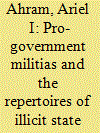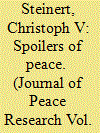| Srl | Item |
| 1 |
ID:
144871


|
|
|
|
|
| Summary/Abstract |
Most studies of pro-government militias (PGMs) take a narrowly functionalist approach. This article sees PGMs as the product of broader processes of state formation and regime dynamics that generate distinctive repertoires of violence. The article uses a cross-national dataset to shows that low state capacity is singularly correlated with the appearance and activity of all forms of PGMs. Once militias are active, they tend to endure even after initial conditions change, suggesting a strong measure of path dependence in how states PGMs evolve. Democracy curbs the activity of semi-official PGMs but not informal ones. Different authoritarian regime sub-types have varying propensities for militia activity. These findings have major implications for efforts to address state frailty.
|
|
|
|
|
|
|
|
|
|
|
|
|
|
|
|
| 2 |
ID:
165452


|
|
|
|
|
| Summary/Abstract |
This study investigates how deployment of pro-government militias (PGMs) as counterinsurgents affects the risk of conflict recurrence. Militiamen derive material and non-material benefits from fighting in armed conflicts. Since these will likely have diminished after the conflict’s termination, militiamen develop a strong incentive to spoil post-conflict peace. Members of pro-government militias are particularly disadvantaged in post-conflict contexts compared to their role in the government’s counterinsurgency campaign. First, PGMs are usually not present in peace negotiations between rebels and governments. This reduces their commitment to peace agreements. Second, disarmament and reintegration programs tend to exclude PGMs, which lowers their expected and real benefits from peace. Third, PGMs might lose their advantage of pursuing personal interests while being protected by the government, as they become less essential during peacetimes. To empirically test whether conflicts with PGMs as counterinsurgents are more likely to break out again, we identify PGM counterinsurgent activities in conflict episodes between 1981 and 2007. We code whether the same PGM was active in a subsequent conflict between the same actors. Controlling for conflict types, which is associated with both the likelihood of deploying PGMs and the risk of conflict recurrence, we investigate our claims with propensity score matching, statistical simulation, and logistic regression models. The results support our expectation that conflicts in which pro-government militias were used as counterinsurgents are more likely to recur. Our study contributes to an improved understanding of the long-term consequences of employing PGMs as counterinsurgents and highlights the importance of considering non-state actors when crafting peace and evaluating the risk of renewed violence.
|
|
|
|
|
|
|
|
|
|
|
|
|
|
|
|